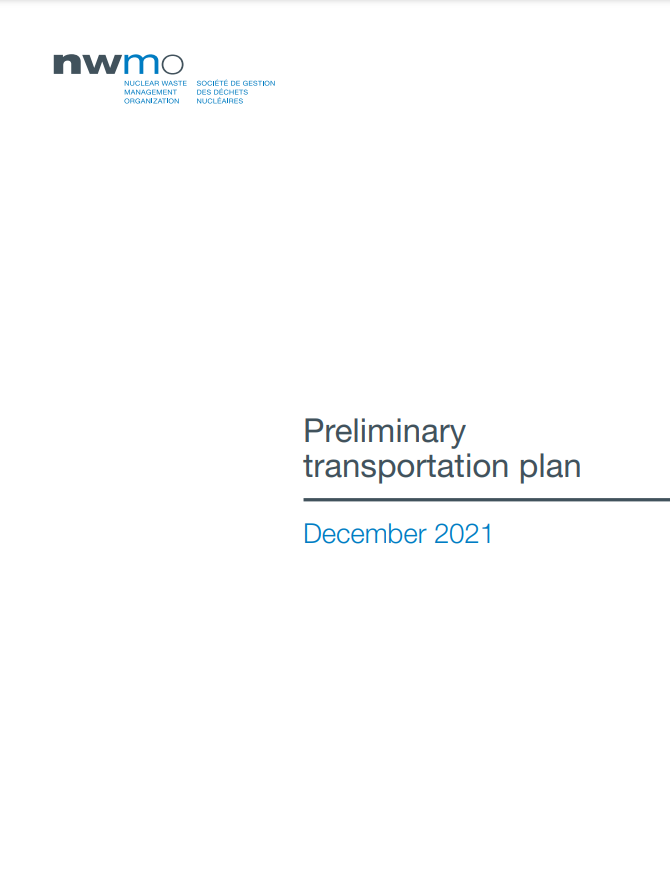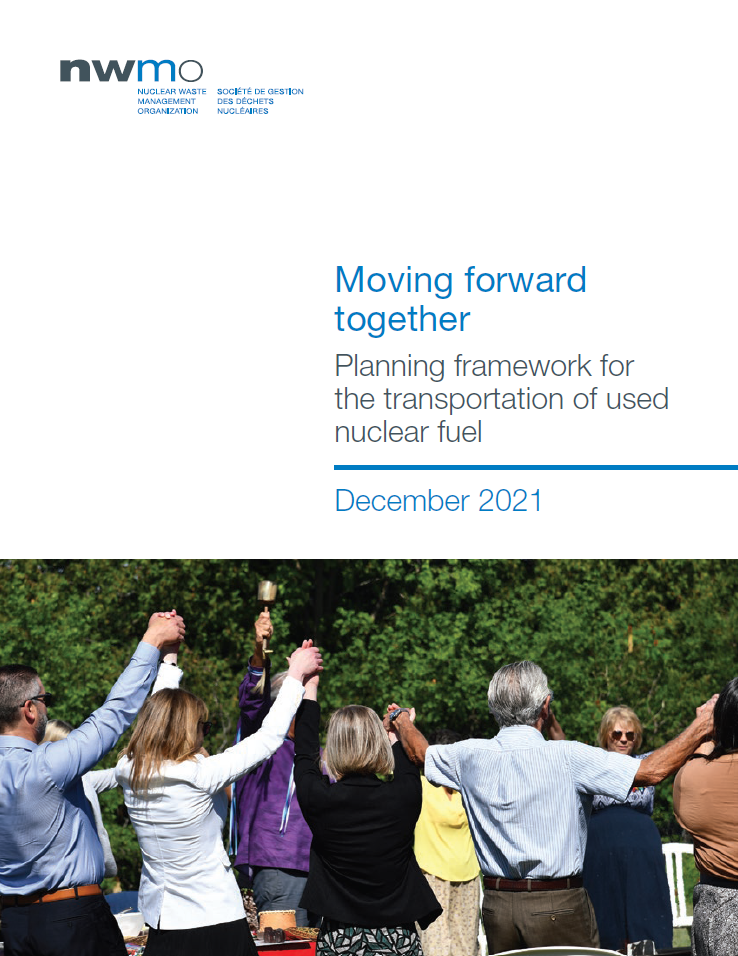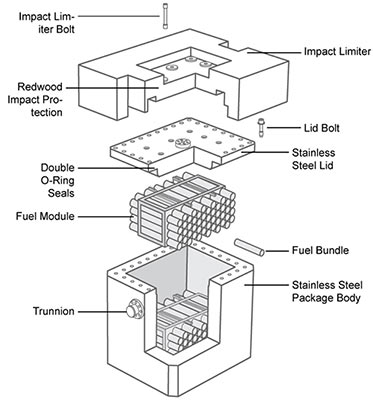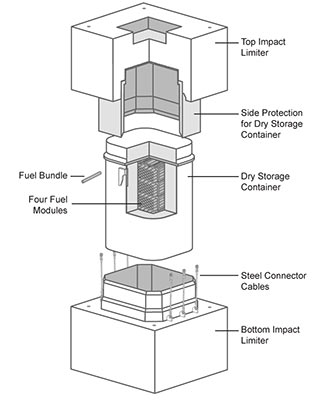Transporting used nuclear fuel
Canada's plan for the safe, long-term management of used nuclear fuel includes transporting it from current interim storage facilities to a deep geological repository, a system of naturally occurring and engineered barriers, to be centrally contained and isolated over the long term.

Transportation planning
The NWMO is working to develop a transportation planning framework that is informed by public input and dialogue.
Overview
Safety is at the core of Canada’s plan and is integrated into every aspect of the transportation system, ensuring the protection of people and the environment. The NWMO's transportation program also includes technical aspects to meet regulatory requirements, as well as public engagement activities to address people's priorities, questions and concerns.
Documents:
- What we heard about the draft transportation planning framework: 2020-21
- Moving forward together: An invitation to review a draft planning framework for the transportation of used nuclear fuel
- Planning Transportation for Adaptive Phased Management: Dialogue to date
- Safe and Secure Transportation of Canada's Used Nuclear Fuel
- Safe and Secure Transportation of Canada's Used Nuclear Fuel: Questions and Answers
- Transportation themes 2014 to 2019: What we heard about transportation planning
- Transportation themes 2014 to 2018: What we heard about transportation planning
- Transportation Themes 2014-2017: What We Heard About Transportation Planning from Working with Communities
Additional documents
#DidYouKnow: How are we planning to safely transport used nuclear fuel in Canada?
Watch now
Transportation planning
As part of the process, we engage with and seek input from Canadians, Indigenous peoples and organizations with a shared interest in future transportation.
The NWMO is working to develop a socially acceptable transportation planning framework that is informed by public input and dialogue.
Transportation
Webinar: Collaborative transportation planning
Watch now
Transportation planning framework
The NWMO has engaged with thousands of Canadians, Indigenous Peoples and organizations to understand their perspectives, suggestions, questions and concerns regarding the transportation of Canada's used nuclear fuel. Through this dialogue, a socially acceptable framework for future transportation planning is emerging.
In 2020, the NWMO published Moving forward together: An invitation to review a draft planning framework for the transportation of used nuclear fuel. The draft framework outlines what we heard and understand from the public about how to implement this phase of Canada’s plan, and includes planning objectives, issues to be addressed and factors the NWMO needs to consider.
In 2021, the NWMO published What we heard about the draft transportation planning framework, a summary of the results from engagement on the draft transportation planning framework.
The public input received was incorporated into two planning documents that address the wide range of priorities, questions and concerns heard to date from Canadians and Indigenous Peoples about the transportation of used nuclear fuel.
Moving forward together: Planning framework for the transportation of used nuclear fuel sets out objectives, priorities and considerations for transporting used nuclear fuel. It was informed by public feedback on an initial draft released in August 2020.
The Preliminary transportation plan provides an overview of the technical approaches, regulatory requirements and planning assumptions the NWMO will build on to ensure safe and secure transportation that protects people and the environment.
The NWMO’s transportation approach will be subject to ongoing review and public reporting. Now that a site has been selected for the repository, with Wabigoon Lake Ojibway Nation and the Township of Ignace as host communities, the NWMO will continue to review and revise the transportation planning framework to reflect evolving best practices, new technologies and ongoing adaptation and continuous improvement.
Additional information in Indigenous languages
Download:
- Safe and Secure Transportation of Canada's Used Nuclear Fuel — Oji-Cree
- Safe and Secure Transportation of Canada's Used Nuclear Fuel — Eastern Ojibwe
- Safe and Secure Transportation of Canada's Used Nuclear Fuel — Western Ojibwe
- Safe and Secure Transportation of Canada's Used Nuclear Fuel — Swampy Cree
Related FAQs
View all FAQsCan used nuclear fuel be transported safely?
The transportation of radioactive material is a well-established practice. Approximately one million packages of nuclear substances are transported in Canada every year. They move by land, air and sea, under strict regulation that ensures that they pose very little threat. As for used nuclear fuel specifically, Canada has proven, and continues to demonstrate, its ability to safely transport used fuel, with hundreds of shipments made since the 1960s. Other countries have shipped 20,000 shipments worldwide by road, rail and water over the past 50 years. There have been zero serious injuries, health effects or environmental consequences.
How long will it take to transport Canada’s used nuclear fuel to the final site?
The transportation, handling and placement of the currently projected inventory of used nuclear fuel in the repository is expected to occur over a period of about 45 to 50 years — from the 2040s to 2080s.
How is the transportation of used nuclear fuel regulated?
The transportation of used nuclear fuel is regulated by the Canadian Nuclear Safety Commission and Transport Canada.
Used nuclear fuel shipments will meet the International Atomic Energy Agency’s safeguard requirements to ensure they are secure.
Transportation operations will meet federal, provincial and local safety requirements and will be inspected for compliance.
We will need to demonstrate to regulatory authorities the safety and security of a transportation system before shipments of used fuel can begin.
How durable is the package that is used to transport used nuclear fuel?
Used nuclear fuel transportation packages are designed and tested to ensure the protection of the public during normal operations, as well as during accident conditions. Before a transportation package can be used in Canada, the design must be certified by the Canadian Nuclear Safety Commission to meet regulatory requirements — which incorporate international safety standards — and the package must be able to withstand severe impact, fire and immersion.
Each test is designed to demonstrate the package’s ability to withstand accident conditions without releasing its contents. To gauge the cumulative effects on the transportation package design, the first two tests are conducted in the sequence that will result in the most damage to the package, followed by the thermal test. The immersion test is conducted independently and is designed to evaluate the integrity of the package under pressure. The order and types of tests are considered to correspond to real transport accident scenarios.
We are assessing the transportation of used nuclear fuel using two package designs:
Used Fuel Transportation Package (UFTP):
Dry Storage Container Transportation Package (DSC-TP):




